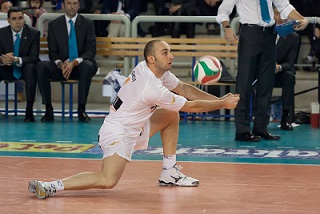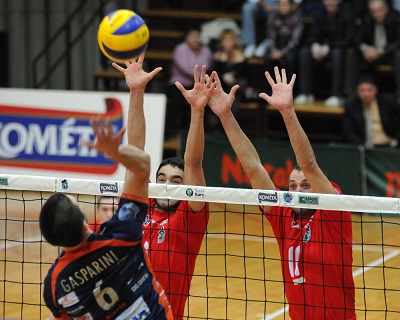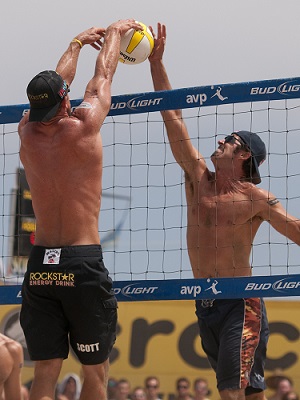Developing Skills in Volleyball
Generally, you can classify all skills in volleyball into one of two categories...
Hard Skill or Soft Skill
In the world of work, hard skills are technical or administrative procedures.
Examples include machine operation, financial procedures and sales administration.
These skills are typically easy to observe, quantify and measure.
By contrast, soft skills (also called people skills) are typically hard to observe, quantify and measure.
People skills have to do with how people relate to each other.
Examples are communicating, listening, solving problems, and resolving conflict.
"Hard" Skills in Sports
In sports, it can be helpful to classify skills as either "hard" or "soft".
Hard skills in sports are the actions that are performed as correctly and consistently as possible.
Some examples are...
- The technique of shooting a free throw in basketball.
- The technique of serving in volleyball.
-
The technique for "long snapping" in American football.
The "Hard" skills in volleyball are all about repeatable precision.
Soft Skills for Sports
Soft skills have many different paths to a good result.
These skills in volleyball aren't about doing the same thing every time.
These skills involve recognizing patterns and making smart, timely choices.
Soft skills often involve communication.
Some examples are
...
In basketball, a point guard sensing a weakness in the opponents defense and deciding to attack.
In volleyball, a coach sensing the opponent gaining momentum, then calling a timeout.
The ability to quickly recognize a pattern or possibility is an important soft skill.
Developing soft skills involves processing information very quickly.
For example, a blocker often needs to make very quick decisions. A
really good blocker will recognize when a ball is set tight to the net,
then quickly penetrate the net to block the ball.
Getting in position with hands
surrounding the ball leaving the hitter with hardly anywhere to go is a very dynamic skill that the blocker developed
by learning to quickly recognize when this opportunity presents itself.
Serving Skills in Volleyball
The skills involved in playing volleyball can be classified as either
"hard" or "soft" or a combination of both "hard" and "soft".
Serving would be classified as a hard skill in volleyball.
Serving can be thought of as a hard skill because the serve is a precise repeatable athletic movement.
Serving is the one skill in volleyball that the server has complete control over executing.
A great server can perform the skill the same way every single time.
Tips for serving...
When you serve, you should have a routine you perform every single time you serve.
The following are coaching cues for serving.
- Bow and Arrow. The hitting arm is drawn back, similar to the string back in archery.
- Slightly Open Stance. Left foot forward and pointing at the target.
- Hold Ball in One Hand. Ball in the left hand and up in front of the hitting shoulder.
- Hitting Elbow Up. Even or above shoulder height.
- Precise Toss. Two or three feet in front of hitting arm, extend hand out and up with ball.
- Step-Toss-Hit. Reach, watch hand hit ball.
- Swing to Target. Bow-and-arrow swing.
- Like Throwing a Ball. Palm of Hand to target.
If you enjoyed these tips and would like to keep it close to you at any time, just save this pin to your Pinterest Volleyball Training Board.
Passing Skills in Volleyball
Forearm passing can be thought of as a combination of hard and soft skills.
Hard skills for forearm passing...
- Hands in front of knees. Start in a ready position with slightly staggered feet, shoulder-width apart, and right foot forward.
- Thumbs and wrists together, elbows straight and flat, platform out early under the ball. You want the fat part of your arms to make contact with the ball, elbows straight and simple, and make a flat surface.
- Feet to the ball. Face the direction the ball is coming from. Angle the arms to the target.
- Beat the ball to the spot.
- Shuffle.
- Face the ball, angle the arms. To angle the arms, shoulder must be lower on the side closest to the intended target.

Soft skills involve reading, recognizing, and reacting
Read the server and flight of the ball. Reading involves noticing "clues".
The best passers watch the server for clues to what's going to happen.
Most servers are consistent in how they serve. For example, when serving
short, the server will often contact the ball back behind the head.
Pay attention to how the ball is tossed. A ball tossed out in front will be served lower.
Focus on picking up clues like this each time the server goes back to serve.
Also watch the flight of the ball and spin. If the ball has topspin, it
will likely drop more as it's coming to your side of the court.
Being able to recognize the spin of the ball will help you prepare to get in position to make the play.
Recognizing patterns and reacting is especially important for playing defense.
When playing defense, focus on what is happening
on the other side of the net.
Watch for Patterns
A ball that's set off the net will likely be hit deeper into the court.
Watch the hitter get in position to hit. If when getting in position, the ball is further back behind the head than the hitter expected, the ball will be hit
up more and likely deep. If the ball is further in front of the hitter (this usually happens on sets that are
lower than expected), the ball will be hit more downward.
Watching for clues as to what's going to happen is important for getting in position to make plays.
Don't worry so much about errors.
When practicing soft skills in volleyball, don't worry too much about making errors. What's important is to explore and experiment.
When first learning to read, be alright with making mistakes. When first
learning, you'll likely make a lot of bad reads. Let this be
alright. Accept the fact that this is where you are in the learning
process.
Practicing soft skills in volleyball are often
a lot of fun, but also tougher because you need to coach yourself. Constantly ask yourself what worked, what didn't, and why.
Volleyball › Coaching Volleyball › Hard Skills in Volleyball


